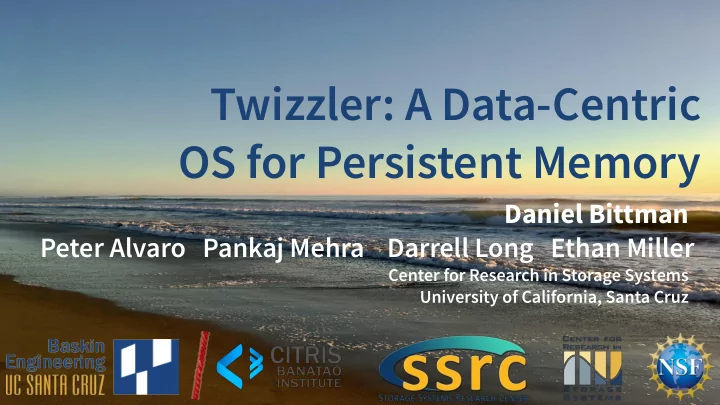

Twizzler: A Data-Centric OS for Persistent Memory Daniel Bittman Peter Alvaro Pankaj Mehra Darrell Long Ethan Miller Center for Research in Storage Systems University of California, Santa Cruz 1
Hardware Trends sys_read ~100-300 ns ~1 us ~1-10 ms Growing, becoming persistent Outdated interface Cannot compute on directly Persistent data should be operated on directly and like memory 2
Global Object Space: Abstract References Persistent data should be operated on directly and like memory Process 1 A B A B Process 2 C B A 3
Existing approaches? POSIX PMDK Explicit persistence and data access No OS support Multiple forms of data Data sharing is hard Kernel involvement Slow pointers mmap helps, but does not solve the virtual memory problem Twizzler’s goals Little kernel involvement Pervasive support (security, sharing) Low overhead persistent pointers 4
Design Overview direct access application (memory-style) musl* libc POSIX access Linux syscall twix emulation (read/write) data object view management, metadata & FOT libtwz pointer translation, management consistency primitives userspace kernelspace object & thread create, delete, etc. Twizzler kernel management, trusted physical mapping computing base * modified musl to change linux syscalls into function calls 5
Persistent Pointers Pointers may be cross-object : referring to data within a different object 1 <offset> offset object-id O 1 A rw- offset FOT entry 2 B r-- FOT 64-bits A Foreign Object Table 1 object ID or Name Name Resolver flags 2 object ID or Name Name Resolver flags ... FOT entry of >0 means “cross-object”—points to a Object Layout different object. FOT Data 6
Implications for Data and Sharing Objects are self-contained Persistent pointers are based on identity not location Persistent pointers can be operated on generically Objects can be easily shared Pointers in Twizzler Pointers in PMDK offset offset FOT entry object ID 64-bits 128-bits Coordination free sharing 64-bit IDs require global coordination or collision management 7
Consistency and Security Cryptographically signed capabilities for access control The kernel cannot create capabilities, but it can (must) verify them. All enforcement must be done by hardware. 8
Implementation More details available at twizzler.io 9
Evaluation Goals Programmability, not performance (though, performance where we can get it) 10
Case Study: KVS Data Index Lookup returns direct pointers 250 lines of simple C code is all you need r-- Data 1 Index Data 2 --- 11
Evaluation Dell R640 Servers with Intel Optane DC Ported SQLite to Twizzler and to PMDK Compared to SQLite “native” and SQLite “LMDB” (mmap) 12
Performance: SQLite 13
Performance: SQLite 14
Future Work: Distributed Twizzler It’s a rendezvous problem Explicit Relationships and the Object Graph C node A B D data code 15
Conclusion Operating systems must evolve to support persistent data programming models directly Cross-object pointers allow us to realize the power of UNIX in a data-centric model Twizzler provides benefits for both NVM and traditional systems 16
Thank You! Questions? 17
Recommend
More recommend